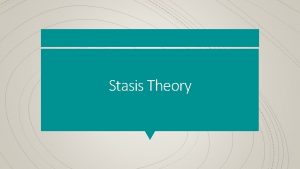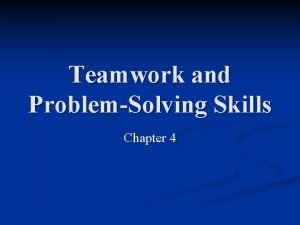Stasis Theory for Research and Teamwork Introduction Stasis











- Slides: 11

Stasis Theory for Research and Teamwork

Introduction Stasis Theory for Research (from The OWL at Purdue) • Stasis theory can help writers build information for all types of communication, and it can help writers conduct careful inquiry for exploratory and empirical research. • Stasis theory is good for conducting research, because it acts as a series of analytical questions that helps writers collect information about the problem, issue, or topic under investigation. When answering the stasis questions, writers should try to gather information from a number of different credible resources, both primary (interviews, etc. ) and secondary (literature review, etc. ), to triangulate their data

Specifically, stasis theory asks writers to investigate and try to determine: • the facts (conjecture) • the meaning or nature of the issue (definition) • the seriousness of the issue (quality) • the plan of action (policy).

Fact • • • Did something happen? What are the facts? Is there a problem/issue? How did it begin and what are its causes? What changed to create the problem/issue? Can it be changed? It may also be useful to ask critical questions of your own research and conclusions: • Where did we obtain our data and are these sources reliable? • How do we know they're reliable?

Definition • • • What is the nature of the problem/issue? What exactly is the problem/issue? What kind of a problem/issue is it? To what larger class of things or events does it belong? What are its parts, and how are they related? It may also be useful to ask critical questions of your own research and conclusions: • Who/what is influencing our definition of this problem/issue? • How/why are these sources/beliefs influencing our definition?

Quality • • • Is it a good thing or a bad thing? How serious is the problem/issue? Whom might it affect (stakeholders)? What happens if we don't do anything? What are the costs of solving the problem/issue? It may also be useful to ask critical questions of your own research and conclusions: • Who/what is influencing our determination of the seriousness of this problem/issue? • How/why are these sources/beliefs influencing our determination?

Policy • Should action be taken? • Who should be involved in helping to solve the problem/address the issue? • What should be done about this problem? • What needs to happen to solve this problem/address this issue? It may also be useful to ask critical questions of your own research and conclusions: • Who/what is influencing our determination of what to do about this problem/issue? • How/why are these sources/beliefs influencing our determination?

The graphic below illustrates how information built using the stasis questions is used in an exploratory white paper, an audience analysis and problem solution report. These documents might be assigned in a composition or professional writing course, or you might have to conduct research for these types of communications in the workplace.

The stasis questions can also be integrated into maps that illustrate exploratory and empirical research methods. The map below illustrates how the stases can be used to help explore an issue before writers form a thesis or argument.

The stasis questions can also help guide empirical research and argumentative work associated with problem-solution papers and reports, as illustrated in the map below.

Lastly, the stasis questions can help identify important gaps in knowledge. If you cannot answer some of the stasis questions effectively, you have identified a gap in knowledge that might need to be filled by conducting more research.





















